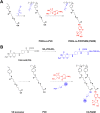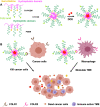Engineering a folic acid-decorated ultrasmall gemcitabine nanocarrier for breast cancer therapy: Dual targeting of tumor cells and tumor-associated macrophages
- PMID: 35530140
- PMCID: PMC9072252
- DOI: 10.1016/j.apsb.2021.09.024
Engineering a folic acid-decorated ultrasmall gemcitabine nanocarrier for breast cancer therapy: Dual targeting of tumor cells and tumor-associated macrophages
Abstract
Combination of passive targeting with active targeting is a promising approach to improve the therapeutic efficacy of nanotherapy. However, most reported polymeric systems have sizes above 100 nm, which limits effective extravasation into tumors that are poorly vascularized and have dense stroma. This will, in turn, limit the overall effectiveness of the subsequent uptake by tumor cells via active targeting. In this study, we combined the passive targeting via ultra-small-sized gemcitabine (GEM)-based nanoparticles (NPs) with the active targeting provided by folic acid (FA) conjugation for enhanced dual targeted delivery to tumor cells and tumor-associated macrophages (TAMs). We developed an FA-modified prodrug carrier based on GEM (PGEM) to load doxorubicin (DOX), for co-delivery of GEM and DOX to tumors. The co-delivery system showed small particle size of ∼10 nm in diameter. The ligand-free and FA-targeted micelles showed comparable drug loading efficiency and a sustained DOX release profile. The FA-conjugated micelles effectively increased DOX uptake in cultured KB cancer cells that express a high level of folate receptor (FR), but no obvious increase was observed in 4T1.2 breast cancer cells that have a low-level expression of FR. Interestingly, in vivo, systemic delivery of FA-PGEM/DOX led to enhanced accumulation of the NPs in tumor and drastic reduction of tumor growth in a murine 4T1.2 breast cancer model. Mechanistic study showed that 4T1.2 tumor grown in mice expressed a significantly higher level of FOLR2, which was selectively expressed on TAMs. Thus, targeting of TAM may also contribute to the improved in vivo targeted delivery and therapeutic efficacy.
Keywords: Breast cancer; Doxorubicin; Dual targeting; Folic acid; Gemcitabine; Polymeric micelles; Tumor associated macrophages; Ultrasmall nanocarrier.
© 2022 Chinese Pharmaceutical Association and Institute of Materia Medica, Chinese Academy of Medical Sciences. Production and hosting by Elsevier B.V.
Figures











Similar articles
-
Targeted delivery of Doxorubicin by folic acid-decorated dual functional nanocarrier.Mol Pharm. 2014 Nov 3;11(11):4164-78. doi: 10.1021/mp500389v. Epub 2014 Sep 29. Mol Pharm. 2014. PMID: 25265550 Free PMC article.
-
Dual pH/reduction-responsive hybrid polymeric micelles for targeted chemo-photothermal combination therapy.Acta Biomater. 2018 Jul 15;75:371-385. doi: 10.1016/j.actbio.2018.05.026. Epub 2018 May 17. Acta Biomater. 2018. PMID: 29777957
-
All-Trans Retinoic Acid and Doxorubicin Delivery by Folic Acid Modified Polymeric Micelles for the Modulation of Pin1-Mediated DOX-Induced Breast Cancer Stemness and Metastasis.Mol Pharm. 2021 Nov 1;18(11):3966-3978. doi: 10.1021/acs.molpharmaceut.1c00220. Epub 2021 Sep 27. Mol Pharm. 2021. PMID: 34579532
-
Folate-modified poly(2-ethyl-2-oxazoline) as hydrophilic corona in polymeric micelles for enhanced intracellular doxorubicin delivery.Int J Pharm. 2013 Nov 18;456(2):315-24. doi: 10.1016/j.ijpharm.2013.08.071. Epub 2013 Sep 7. Int J Pharm. 2013. PMID: 24016742
-
Reduction-sensitive CD44 receptor-targeted hyaluronic acid derivative micelles for doxorubicin delivery.Int J Nanomedicine. 2018 Jul 26;13:4361-4378. doi: 10.2147/IJN.S165359. eCollection 2018. Int J Nanomedicine. 2018. PMID: 30100720 Free PMC article.
Cited by
-
Dual-Action Gemcitabine Delivery: Chitosan-Magnetite-Zeolite Capsules for Targeted Cancer Therapy and Antibacterial Defense.Gels. 2024 Oct 21;10(10):672. doi: 10.3390/gels10100672. Gels. 2024. PMID: 39451325 Free PMC article.
-
Single-cell resolution characterization of myeloid-derived cell states with implication in cancer outcome.Nat Commun. 2024 Jul 7;15(1):5694. doi: 10.1038/s41467-024-49916-4. Nat Commun. 2024. PMID: 38972873 Free PMC article.
-
M2 Tumor-Associated Macrophages-Derived Exosomal MALAT1 Promotes Glycolysis and Gastric Cancer Progression.Adv Sci (Weinh). 2024 Jun;11(24):e2309298. doi: 10.1002/advs.202309298. Epub 2024 Apr 19. Adv Sci (Weinh). 2024. PMID: 38639382 Free PMC article.
-
Immunostimulatory CKb11 gene combined with immune checkpoint PD-1/PD-L1 blockade activates immune response and simultaneously overcomes the immunosuppression of cancer.Bioact Mater. 2024 May 23;39:239-254. doi: 10.1016/j.bioactmat.2024.05.014. eCollection 2024 Sep. Bioact Mater. 2024. PMID: 38832303 Free PMC article.
-
Unveiling the key mechanisms of FOLR2+ macrophage-mediated antitumor immunity in breast cancer using integrated single-cell RNA sequencing and bulk RNA sequencing.Breast Cancer Res. 2025 Mar 5;27(1):31. doi: 10.1186/s13058-025-01980-4. Breast Cancer Res. 2025. PMID: 40045365 Free PMC article.
References
-
- Cabral H., Matsumoto Y., Mizuno K., Chen Q., Murakami M., Kimura M., et al. Accumulation of sub-100 nm polymeric micelles in poorly permeable tumours depends on size. Nat Nanotechnol. 2011;6:815. - PubMed
-
- Hrkach J., Von Hoff D., Ali M.M., Andrianova E., Auer J., Campbell T., et al. Preclinical development and clinical translation of a PSMA-targeted docetaxel nanoparticle with a differentiated pharmacological profile. Sci Transl Med. 2012;4 128ra39. - PubMed
Publication types
Grants and funding
LinkOut - more resources
Full Text Sources
Research Materials

